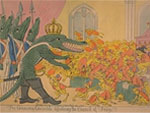
| Napoleon was sometimes likened to a crocodile, the animal symbolizing Egypt. On his return from this country, he organized his coup d'etat on the 18 and 19 Brumaire and sent away the members of the "Conseil des Anciens". The frog theme is particularly interesting. It suggests how French democracy got caught up in endless debates, the chamber being compared to swamps in which ideas are left to rot. Many English caricatures paid special attention to Napoleon's coup d'etat: while criticizing republican democracy, they nevertheless attacked the young general whom they considered to be an upstart. |
__________
-Saint-Phal-| Announced on March 21, 1815, this caricature was issued as late as the following September because of the Cent-Jours episode. Its extreme violence indeed made it unfit for publication after the Emperor's return from Elba. The print refers to the revolutionary origins of the imperial government. Napoleon is supported but by the riff-raff in the suburbs where he originally found the crown he is looking for at present as times have now changed. An undertaker seems to be ready to burry him and yet the people still support Napoleon. This caricature, one of the most reactionary, illustrates how the aristocrats scorned the people. |
__________
| This caricature was published in English and French simultaneously on March 6, 1813. It is therefore an allusion to Napoleon's alleged desertion during the campaign in Russia on December 5, 1812. Yet Cruikshank goes beyond this in this caricature when he recalls the fact that Napoleon, a son of the revolution, has betrayed the latter and may jeopardize it. According to Grand-Carteret, Cruikshank is supposed to have imagined that a new revolution had taken place in France, and that, instead of Napoleon, a cobbler now ruled the country. This may be true, but the print has one particular aim, that of showing the people what Napoleon was capable of without upsetting them too much while reminding them nevertheless that the Jacobins are butchers and cobblers, etc. Cruikshank's drawing aims at criticizing the revolution and the Emperor alike. The caricature, which was issued in France, set the pace of the ideological struggle which was soon to present the king as the country's only hope. |
__________
-Pierre-Marie Bassompierre Gaston-| This caricature may have been based on a German model by Leonhardt Schlemer (born in 1772) Alte Liebe rostet nicht ("An old love never gets rusty") (B.N., Est., coll. Hennin, 157, p. 6 ; catal. Hanover exhib., p. 336, n° 5.6, pl. XLVIII).This may be the reason why it clearly refers to the revolutionary origins of the Empire.: Napoleon is identified with the Jacobins whose staff -topped with a red bonnet- he holds. From 1793 to 1794 in Toulon, Napoleon, then a young general, was close to followers of Robespierre. Such a direct criticism is seldom to be found in France (contrary to Britain): we already studied the division between Napoleon and the social body in our introduction. |
__________
-Lacroix-| This is one of the most powerful caricatures and one which carries the strongest ideology. It is a pun on the word light which refers to the 18th century's trend of ideas. According to the Royalists, the century of philosophy had given way to the Empire (an age of tyranny, warfare and death). Unfortunate soldiers are being blinded by the smoke caused by cannon-firing, the only symbol of light left under Napoleon. 18th century ideology is nothing but a decoy. This print is a variation on the main theme of the extinguisher. The author of this print was quite right in placing the Empire in the line of the extinguisher. The Napoleonic regime was in fact considered by some historians as the last enlightened monarchy of the 18th century (see L. Bergeron, L’épisode napoléonien. I. Aspects intérieurs, 1799-1815, Paris, Seuil, coll. Nouvelle histoire de la France contemporaine, 4, p. 12). |
__________
-Lacroix-| No better answer can be found to the controversy which took place between Royalists et Bonapartists around the extinguisher theme, around ideological questions in 1814-1815. Lacroix discovered the solution: neither the king nor Napoleon were obscurantists: Blücher and Wellington are throwing Napoleon into the dust bin of history. There was no longer any controversy, it had been solved by the Allies. The bubble, frequently used in Britain, is being used here as it is in other French caricatures, but it is not surrounded by a black line. |
__________
-Lacroix-| This caricature pictures the King of Rome putting a rope/tie around the neck of a bust representing Napoleon with devil's ears. This is the hanging theme, the only punishment Napoleon is worthy of. The King of Rome was used in a few caricatures, especially by George Cruikshank in March 1814 who is believed to be the author of The New Farce which was Performed in Paris with Great Success. This print is however terrifying as far as it suggests the re-education of the duke of Reichstadt. |
__________
-Louis Lecoeur-| This bonapartist caricature criticizes Talleyrand (shown here as acting under the devil's influence), who was accused of abandoning Napoleon upon hearing of the Emperor's return from Elba (hence the text he is writing down). The former minister is in fact considered to have played a rather positive role during the Congress of Vienna. Thanks to him, France was able to keep its conquests dating back to 1793 (Nice and Savoy) together with the works of art stolen by the French during the Directoire and the Empire, and which had been added to the Louvre collections. All this was lost after Waterloo. |
__________
| This print draws on the theme of the head to foot face. The reversal of values is symbolized by Napoleon -a figure of death and war, evil incarnate- and Cambacérès, whose unnatural tastes provided abundant subject-matter for the caricaturists. The print dates back to 1814-1815. |
Th Anti-Napoleon
Napoleon body and soul
The cosmic battle
The great art
Popular culture
The exiled